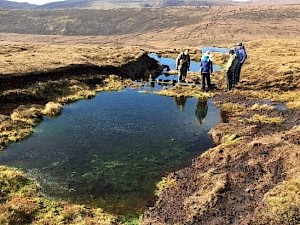
Gully-damming projects like this in the Kames by Shetland Amenity Trust will be studied by SWEAG.
Viking Energy is setting up an independent environmental advisory group for the wind farm along the lines of the respected organisation which has monitored Sullom Voe Oil Terminal for over 40 years.
The Shetland Windfarm Environmental Advisory Group (SWEAG) will oversee the comprehensive programme of conservation measures, outlined in the recently approved Habitat Management Plan (HMP), to restore eroding peat bog on a large scale and boost bird breeding success during the lifespan of the wind farm.
SWEAG is borrowing from the concept of the Shetland Oil Terminal Environmental Advisory Group (SOTEAG), which is renowned globally for its pioneering role in providing scientific monitoring and advice on managing the environment around the large oil complex and its sensitive harbour area.
Viking Energy’s project team sought advice from SOTEAG on how to proceed effectively and is now in the process of creating SWEAG. The group’s membership will include representatives from statutory bodies such as Scottish Natural Heritage and the Scottish Environmental Protection Agency, specialist peatland and ornithology experts and local environmental custodians like Shetland Amenity Trust and Shetland Islands Council.
The key aims of the HMP that SWEAG will monitor and advise on are to carry out 260 hectares of peat restoration and to improve the habitat of the red-throated diver, whimbrel and merlin with a view to increasing their breeding success.
A Viking Energy spokesman said: “We are in the process of seeking the right blend of specialist knowledge and practical experience to help ensure that SWEAG is fully effective in its role.
“SWEAG will be a valuable forum for assessing what works well and what is not effective in improving the sensitive habitat around the wind farm.
“A key aim for SWEAG is to build up a unique database of knowledge of the ecosystems within the windfarm and how best to repair and enhance them. As that body of information grows it will be available to share with all who have an interest in protecting peatlands and the wildlife that live there.”
SWEAG is expected to hold its inaugural meeting in the coming months.